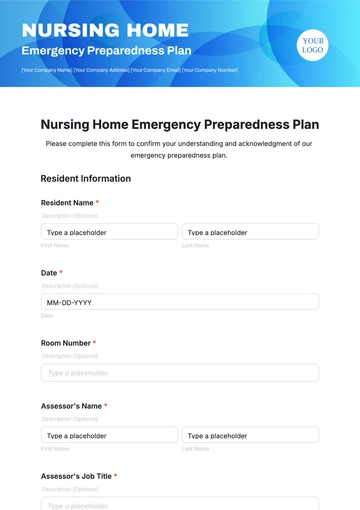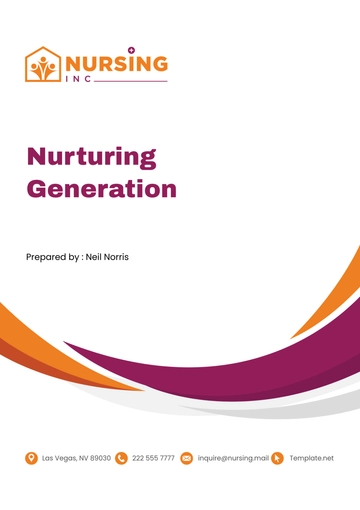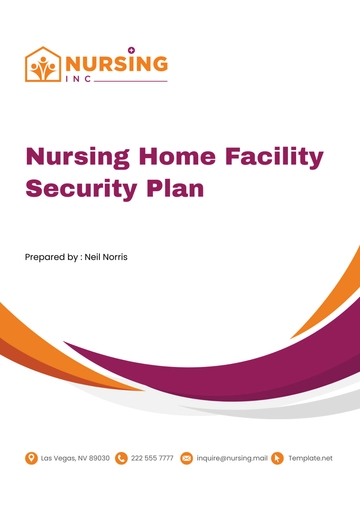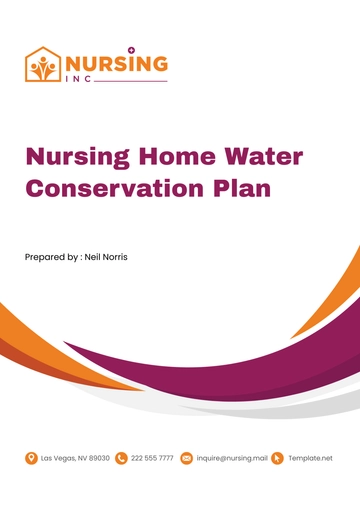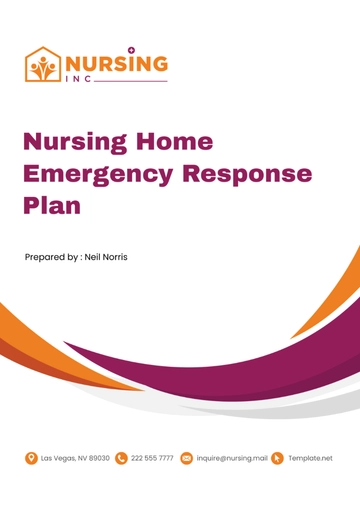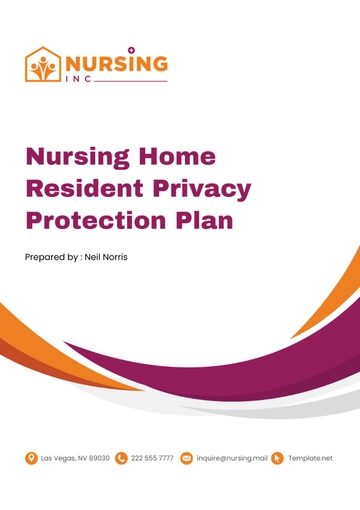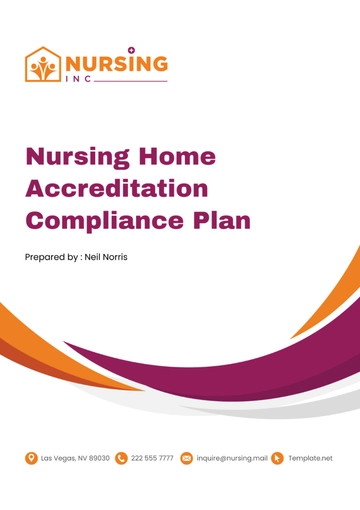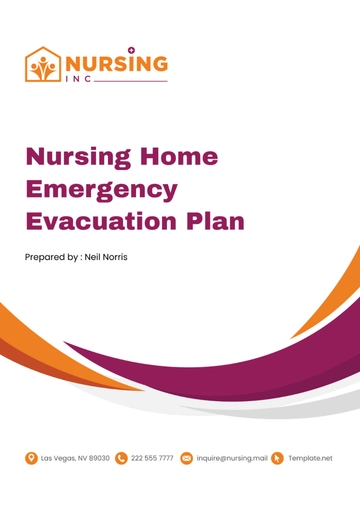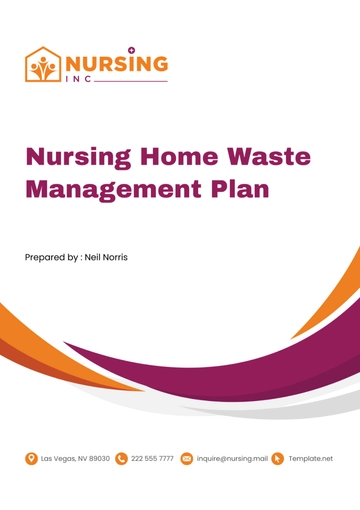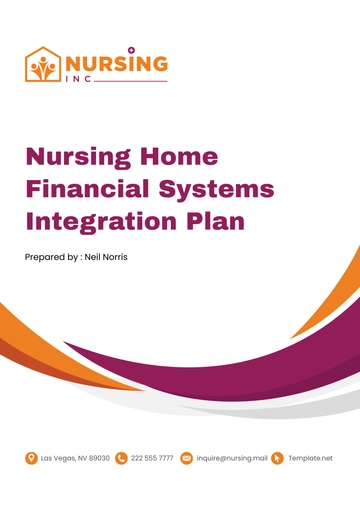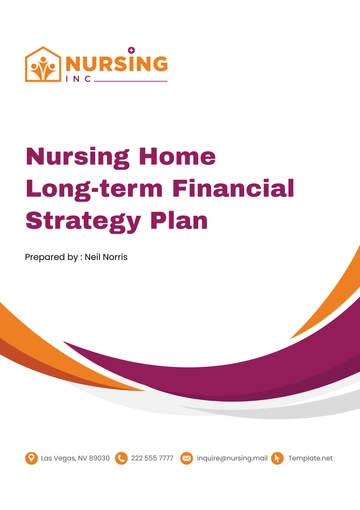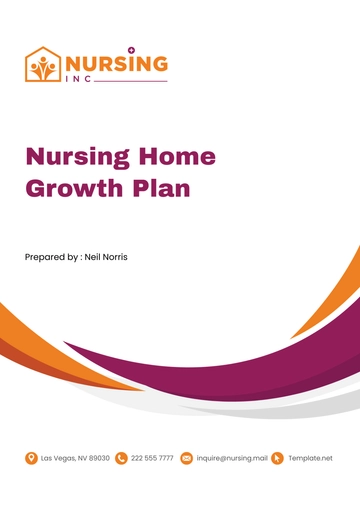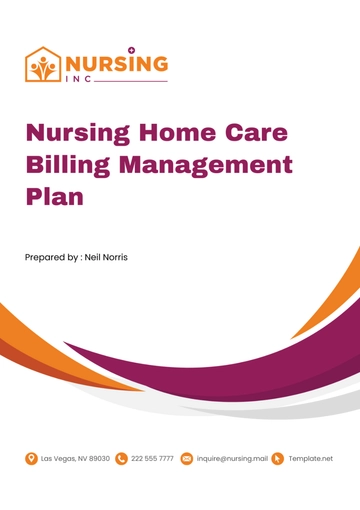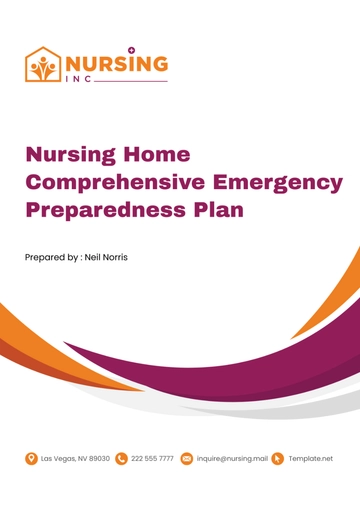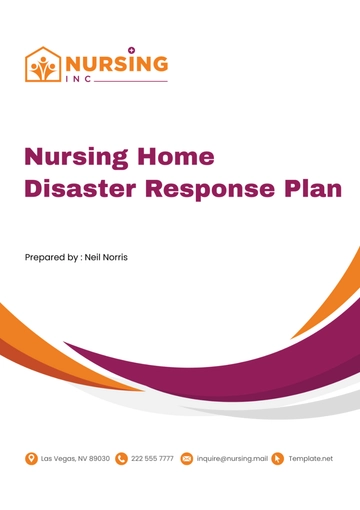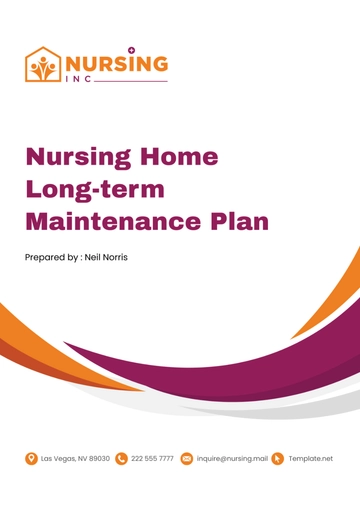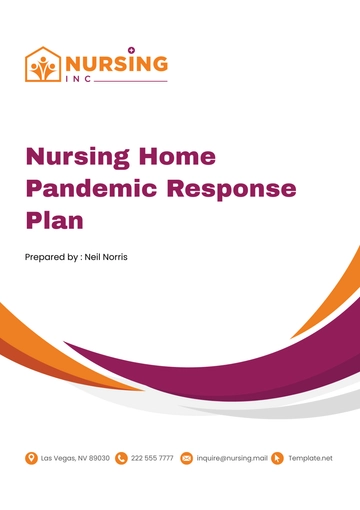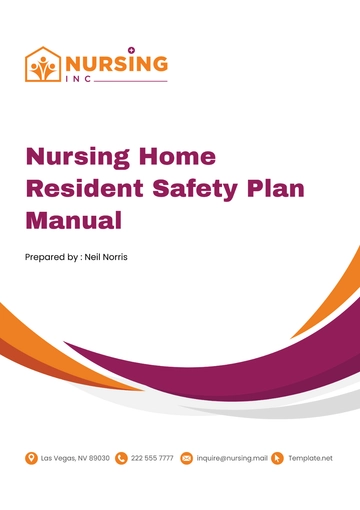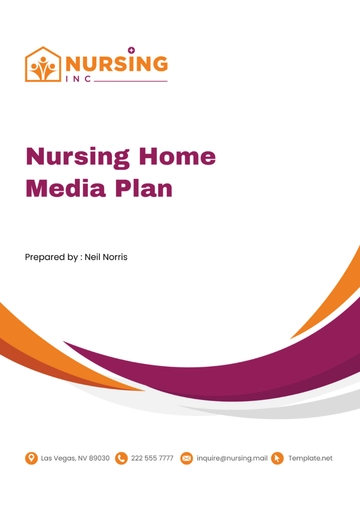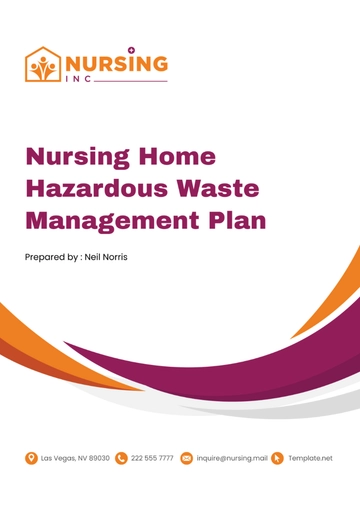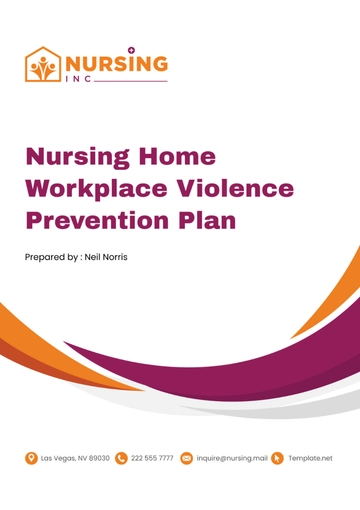Free Nursing Home Waste Management Plan
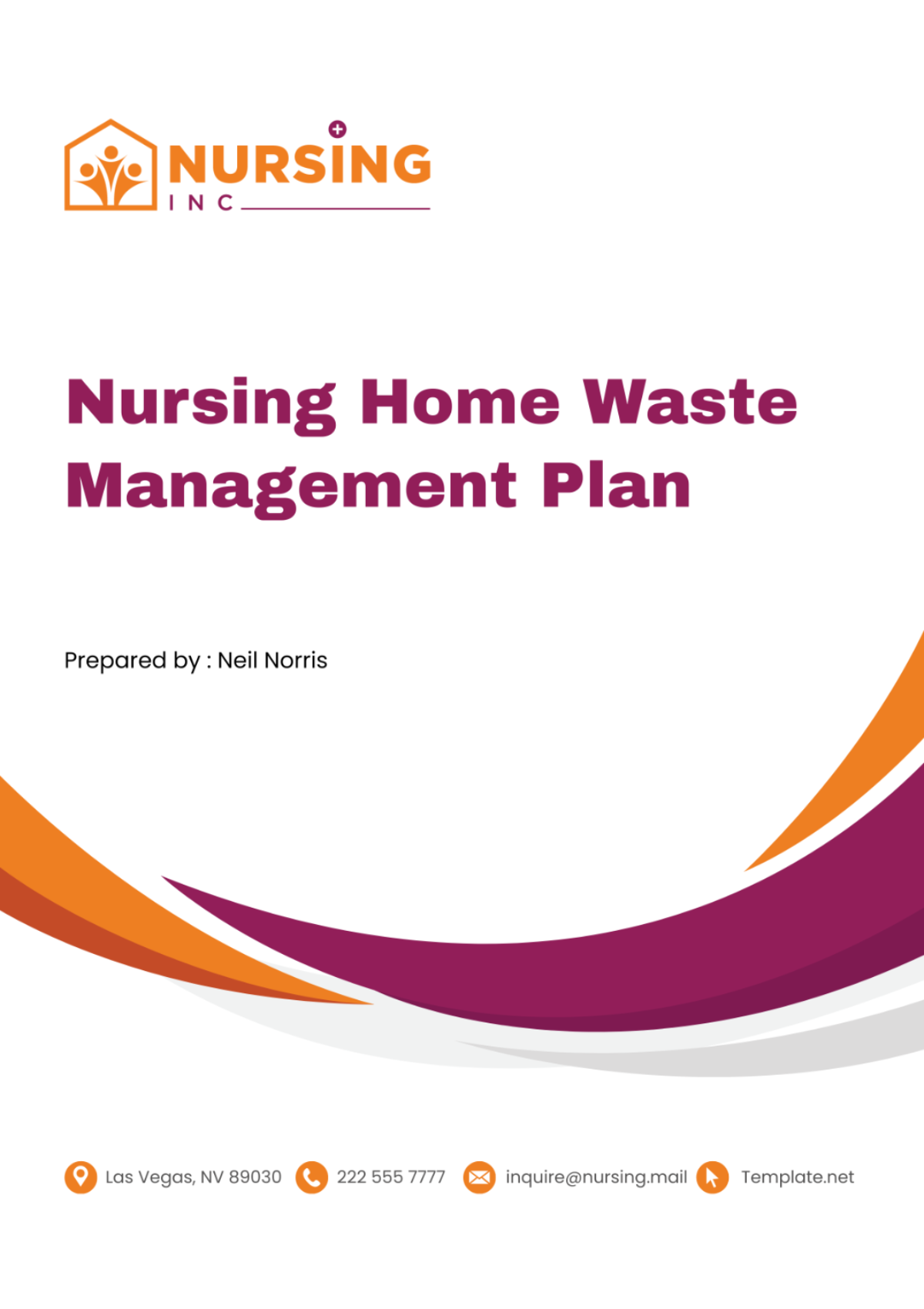
I. Introduction
The purpose of this Waste Management Plan is to outline the systematic approach we employ to manage waste generated within our nursing home facilities. This plan applies to all types of waste generated at our nursing home, including general, medical, hazardous, recyclable, and organic waste. It encompasses activities related to waste minimization, segregation, storage, collection, and disposal. Our objectives are:
To minimize volume of waste generated and reduce environmental footprint.
To ensure proper segregation, storage, and disposal of all types of waste.
To achieve and maintain compliance with all applicable regulations.
To educate and train our staff and residents on best practices.
To continuously improve our waste management processes through regular review and adaptation.
II. Regulatory Compliance
Effective waste management requires adherence to a broad range of regulatory requirements. Our plan is designed to comply with all applicable regulations to ensure environmental protection and public health. We maintain strict compliance to ensure that all waste handling processes are conducted safely and responsibly. Relevant US regulations include:
Resource Conservation and Recovery Act (RCRA)
Health Insurance Portability and Accountability Act (HIPAA)
Clean Air Act (CAA)
Occupational Safety and Health Administration (OSHA) standards
Environmental Protection Agency (EPA) guidelines
III. Types of Waste
Our nursing home generates various types of waste, each requiring specific handling procedures to ensure efficient and compliant waste management practices. The proper identification and segregation of these waste types are crucial for their appropriate treatment and disposal.
A. General Waste
General waste in our facility includes all non-hazardous, non-medical waste that is similar to typical household garbage. This waste does not pose a direct risk to health and is managed with standard disposal methods.
Paper and cardboard (non-confidential)
Kitchen waste that is not classified as organic
General packaging materials
Office waste (staples, non-confidential documents, folders)
Other non-recyclable waste that does not contain hazardous or organic materials
B. Medical Waste
Medical waste encompasses all waste generated in the care of patients that is potentially contaminated with bodily fluids, pharmaceutical substances, or other potentially infectious materials.
Used gloves, bandages, and gauze
Used test strips and swabs
Dialysis waste
Items contaminated with blood or other bodily fluids
Discarded surgical instruments and sharps (needles, syringes, scalpel blades)
C. Hazardous Waste
Hazardous waste includes all waste materials that are dangerous or potentially harmful to human health or the environment. This waste must be handled with special precautions and disposed of according to strict regulations.
Pharmaceuticals (expired or unused medications)
Chemicals (cleaning agents, solvents)
Batteries and electronic waste
Aerosols
Waste containing heavy metals, such as certain types of thermometers and blood pressure cuffs
D. Recyclable Materials
Recyclable materials are those that can be reprocessed and reused, reducing the demand for raw materials and minimizing environmental impact. These materials must be separated from general and hazardous waste to prevent contamination.
Paper and cardboard (clean and unsoiled)
Plastics (bottles, containers, and packaging)
Metals (cans, tins, some medical instruments if deemed safe)
Glass (bottles and jars)
Electronics (computers, monitors, mobile phones)
E. Organic Waste
Organic waste refers to any waste that is biodegradable and can be composted to create soil amendments. Proper management of organic waste helps reduce landfill use and methane emissions.
Food scraps
Floral waste
Biodegradable kitchen waste
Yard waste (leaves, grass clippings, branches)
Soiled paper products that are compostable (e.g., paper towels, napkins)
IV. Waste Minimization and Prevention
Our nursing home prioritizes waste minimization and prevention as essential components of our waste management strategy. By reducing the amount of waste generated, we can decrease our environmental footprint, lower disposal costs, and promote sustainability within our community. This section outlines the strategies we employ to achieve these goals.
A. Source Reduction
Reducing waste at the source is the most effective way to minimize waste generation. We implement source reduction by:
Purchasing products with minimal packaging.
Using durable, reusable products instead of disposables where possible.
Reducing the usage of hazardous substances by substituting them with safer alternatives.
B. Efficient Use of Resources
We aim to use all resources more efficiently to minimize waste, including:
Implementing energy-saving measures to reduce energy waste.
Using water-efficient fixtures and practices to decrease water waste.
Encouraging double-sided printing to reduce paper waste.
C. Reuse Practices
Before disposing of items, we assess whether they can be reused, either within our facility or by donating to other organizations, which includes:
Reusing office supplies like folders and envelopes.
Donating old electronics and furniture that are still in good condition.
Repurposing materials for different uses within the facility.
D. Staff and Resident Training
Training staff and residents is vital to our waste minimization efforts. Regular training ensures everyone understands their role in reducing waste and adheres to our sustainability practices.
Program | Frequency | Duration |
Waste Segregation Awareness | Bi-annually | 1 hour |
Source Reduction Techniques | Annually | 1 hour |
Reuse Opportunities Training | Annually | 1 hour |
Efficient Resource Use Workshop | Annually | 1 hour |
E. Continuous Improvement
We continually seek to improve our waste minimization practices by:
Regularly reviewing and updating our waste management policies.
Monitoring waste streams and identifying new opportunities for waste reduction.
Encouraging feedback and suggestions from staff and residents on how to improve waste practices.
V. Waste Segregation
Effective waste segregation is critical to our waste management process, ensuring that different types of waste are appropriately handled, treated, and disposed of in accordance with regulatory requirements and environmental best practices. Proper segregation reduces contamination, improves recycling rates, and ensures that hazardous and medical wastes are safely managed.
Color-Coded Bin System: We use a color-coded bin system throughout our facility to simplify the segregation process:
Blue bins: Recyclable materials.
Red bins: Medical waste.
Green bins: Organic waste.
Black bins: General waste.
Yellow bins: Hazardous waste.
Labeling and Signage: Clear labels and signs are posted above each bin type to describe what waste is allowed and what is not, preventing cross-contamination.
Training and Communication: Regular training sessions are held for all staff and residents to reinforce proper segregation practices and any updates to our waste handling protocols.
VI. Waste Storage and Collection
The safe storage and timely collection of waste are essential components of our waste management system, ensuring that waste does not pose a health risk to residents and staff and is processed in an environmentally sound manner.
A. Storage Procedures
Designated Storage Areas: Each type of waste has a designated secure storage area that is accessible only to authorized personnel. These areas are well-ventilated, covered, and equipped with spill containment measures.
Regular Maintenance and Cleaning: Waste storage areas are regularly inspected and cleaned to prevent pest infestations and reduce odors, ensuring a hygienic environment.
Security Measures: Storage areas for hazardous and medical waste are locked and under surveillance to prevent unauthorized access and ensure safety.
B. Collection Procedures
Scheduled Pick-ups: Waste is collected at scheduled times, which are communicated in advance to all departments. This ensures that waste does not accumulate, reducing risks associated with overfilled bins.
Type of Waste
Pick-Up Schedule
Disposal Method
General Waste
Daily
Landfill
Recyclable Materials
Twice a week
Recycling facility
Organic Waste
Twice a week
Composting
Medical Waste
Weekly
Incineration/Specialized
Hazardous Waste
Monthly
Specialized treatment
Specialized Collection for Hazardous and Medical Waste: These wastes are collected by certified waste management contractors who specialize in handling and disposing of such materials safely and in compliance with legal requirements.
Documentation and Tracking: We maintain records of all waste collection and disposal activities. This documentation helps us monitor our waste management performance and ensures accountability.
VII. Recycling Programs
Recycling is a fundamental component of our waste management strategy, reducing our environmental impact by diverting waste from landfills and conserving natural resources. Our recycling programs are designed to handle a wide range of materials, including paper, plastics, metals, and glass.
Partnerships with Recycling Facilities: We collaborate with local recycling facilities to ensure that our recyclable materials are processed responsibly. These partnerships help us stay updated with recycling best practices and technological advancements.
Education and Training: We conduct regular training sessions for staff and informational seminars for residents to promote recycling awareness and proper segregation practices.
Recycling Bins and Signage: Clearly marked recycling bins are placed throughout our facility, accompanied by educational posters detailing what can and cannot be recycled.
Targets and Objectives: Our goal is to achieve a recycling rate of at least 50% of all recyclable waste generated by our facility. We monitor progress towards this target regularly and adjust our strategies as needed to improve our recycling rates.
VIII. Monitoring and Reporting
We use a combination of manual tracking and digital tools to record and analyze waste data. This comprehensive approach allows us to track trends and identify areas for improvement. Regular waste audits are conducted semi-annually to assess the accuracy of our waste management practices and ensure compliance with our policies. Detailed reports are generated monthly and reviewed by management. These reports are also submitted to regulatory authorities as required by local and federal laws, maintaining transparency and accountability in our waste management efforts.
- 100% Customizable, free editor
- Access 1 Million+ Templates, photo’s & graphics
- Download or share as a template
- Click and replace photos, graphics, text, backgrounds
- Resize, crop, AI write & more
- Access advanced editor
This Nursing Home Waste Management Plan Template at Template.net helps you efficiently handle waste disposal and recycling processes. This template is fully editable and customizable, facilitating the development of a sustainable waste management strategy, editable in our AI Editor tool. Ensure environmental compliance and operational efficiency in your nursing home with this critical planning tool.
You may also like
- Finance Plan
- Construction Plan
- Sales Plan
- Development Plan
- Career Plan
- Budget Plan
- HR Plan
- Education Plan
- Transition Plan
- Work Plan
- Training Plan
- Communication Plan
- Operation Plan
- Health And Safety Plan
- Strategy Plan
- Professional Development Plan
- Advertising Plan
- Risk Management Plan
- Restaurant Plan
- School Plan
- Nursing Home Patient Care Plan
- Nursing Care Plan
- Plan Event
- Startup Plan
- Social Media Plan
- Staffing Plan
- Annual Plan
- Content Plan
- Payment Plan
- Implementation Plan
- Hotel Plan
- Workout Plan
- Accounting Plan
- Campaign Plan
- Essay Plan
- 30 60 90 Day Plan
- Research Plan
- Recruitment Plan
- 90 Day Plan
- Quarterly Plan
- Emergency Plan
- 5 Year Plan
- Gym Plan
- Personal Plan
- IT and Software Plan
- Treatment Plan
- Real Estate Plan
- Law Firm Plan
- Healthcare Plan
- Improvement Plan
- Media Plan
- 5 Year Business Plan
- Learning Plan
- Marketing Campaign Plan
- Travel Agency Plan
- Cleaning Services Plan
- Interior Design Plan
- Performance Plan
- PR Plan
- Birth Plan
- Life Plan
- SEO Plan
- Disaster Recovery Plan
- Continuity Plan
- Launch Plan
- Legal Plan
- Behavior Plan
- Performance Improvement Plan
- Salon Plan
- Security Plan
- Security Management Plan
- Employee Development Plan
- Quality Plan
- Service Improvement Plan
- Growth Plan
- Incident Response Plan
- Basketball Plan
- Emergency Action Plan
- Product Launch Plan
- Spa Plan
- Employee Training Plan
- Data Analysis Plan
- Employee Action Plan
- Territory Plan
- Audit Plan
- Classroom Plan
- Activity Plan
- Parenting Plan
- Care Plan
- Project Execution Plan
- Exercise Plan
- Internship Plan
- Software Development Plan
- Continuous Improvement Plan
- Leave Plan
- 90 Day Sales Plan
- Advertising Agency Plan
- Employee Transition Plan
- Smart Action Plan
- Workplace Safety Plan
- Behavior Change Plan
- Contingency Plan
- Continuity of Operations Plan
- Health Plan
- Quality Control Plan
- Self Plan
- Sports Development Plan
- Change Management Plan
- Ecommerce Plan
- Personal Financial Plan
- Process Improvement Plan
- 30-60-90 Day Sales Plan
- Crisis Management Plan
- Engagement Plan
- Execution Plan
- Pandemic Plan
- Quality Assurance Plan
- Service Continuity Plan
- Agile Project Plan
- Fundraising Plan
- Job Transition Plan
- Asset Maintenance Plan
- Maintenance Plan
- Software Test Plan
- Staff Training and Development Plan
- 3 Year Plan
- Brand Activation Plan
- Release Plan
- Resource Plan
- Risk Mitigation Plan
- Teacher Plan
- 30 60 90 Day Plan for New Manager
- Food Safety Plan
- Food Truck Plan
- Hiring Plan
- Quality Management Plan
- Wellness Plan
- Behavior Intervention Plan
- Bonus Plan
- Investment Plan
- Maternity Leave Plan
- Pandemic Response Plan
- Succession Planning
- Coaching Plan
- Configuration Management Plan
- Remote Work Plan
- Self Care Plan
- Teaching Plan
- 100-Day Plan
- HACCP Plan
- Student Plan
- Sustainability Plan
- 30 60 90 Day Plan for Interview
- Access Plan
- Site Specific Safety Plan
